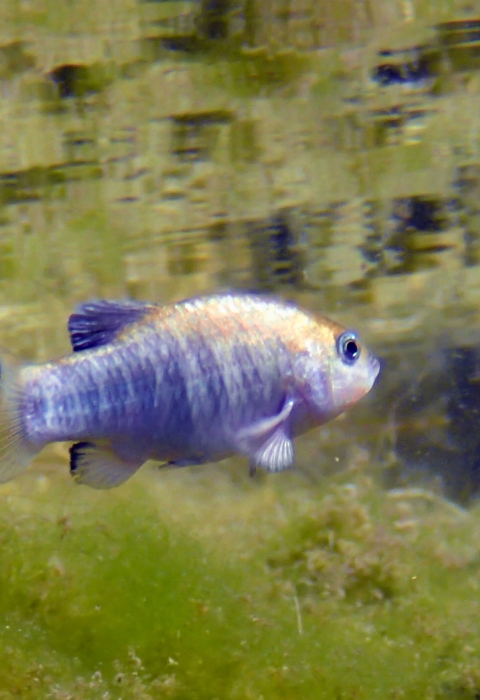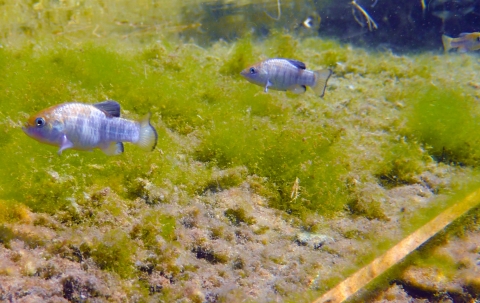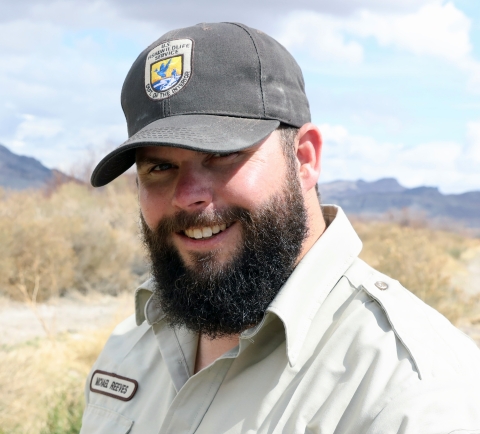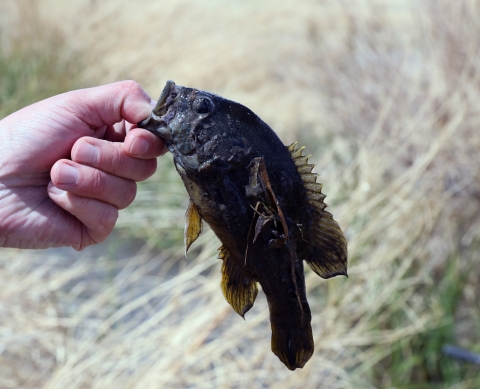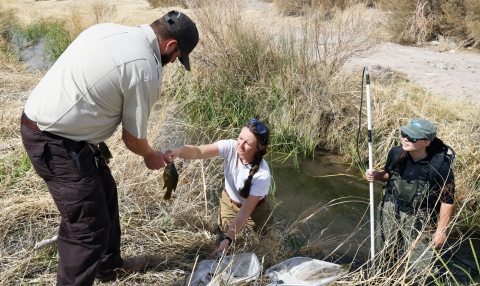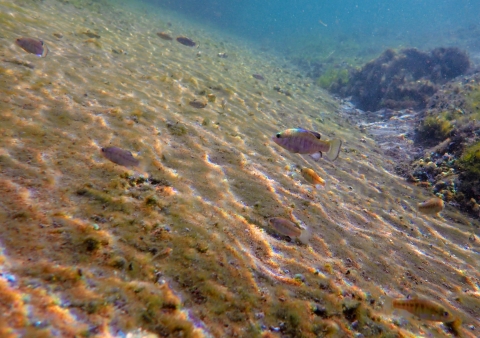Imagine growing up in a system where you are the top predator. Nothing scares you - why would it? That’s precisely the challenge the endangered Ash Meadows Amargosa pupfish has when faced with the invasive green sunfish.
“We call it prey naivety, and essentially it means that the pupfish isn’t scared of the sunfish,” said Michael Reeves, fish and wildlife biologist for the Ash Meadows National Wildlife Refuge managed by the U.S. Fish and Wildlife Service.
An invasive species is any plant or animal that has spread or been introduced into a new area where they are, or could, cause harm to the environment, economy, or human, animal, or plant health. Their unwelcome presence can destroy ecosystems and cost millions of dollars.
Learn more about invasive species ) on the Ash Meadows National Wildlife Refuge. Recent efforts to remove the sunfish have resulted in improved populations of the native Ash Meadows Amargosa pupfish. Credit: John Heil/USFWS
Put simply, the sunfish will eat the pupfish at will. “When these two meet up in the water, there’s no kind of defensive mechanism that the pupfish has evolved with to save it,” added Reeves. “It’s just kind of swimming around free, loving and living its best life. And then this big sunfish comes in and has a fairly easy time with them.”
In came the Service biologists from Ash Meadows with a plan for removal of the sunfish. First, they identified the problem, built a monitoring framework, collecting data and information, and adapted to what they learned for “optimal effectiveness” per refuge manager Mike Bower.
Service efforts have led to the removal of over 200 green sunfish, and the results have been noticeable per Reeves. “You can anecdotally tell that the pupfish population is much, much higher than before the sunfish control efforts started. The quicker we can detect an invasive problem, the easier it is going to be to eradicate that problem.”
In addition to removing invasive species such as green sunfish, the refuge is putting a great deal of effort into restoring the habitat conditions that native species like the pupfish evolved with. In many cases, that means removing agricultural infrastructure that is no longer needed, such as irrigation reservoirs and ditches.
“The sunfish are an example of a species that’s been here for many years, and they’re extremely persistent,” said Leah Simantel, ecological restoration specialist for the refuge. “A big reason that the sunfish are persisting is because of leftover infrastructure, like reservoirs, where they can thrive. It has created a stronghold for those populations, so our plan has been to decommission reservoirs like that and restore to marshy environments, which is going to favor the pupfish.”
The refuge is also developing new tools to assist in its fight against invasive species. Scientists at the Desert Research Institute and Washington State University are helping develop environmental DNA (aka eDNA) tools for early detection of invasive species, allowing the refuge to intervene before populations can become established.
Reeves believes eDNA will not only save time but will confirm eradication. So how do these eDNA tools work? Per Reeves, scientists develop a primer or marker that is specific for the green sunfish. The green sunfish is constantly putting its DNA into the water via excretion, breeding, fighting, etc. Water can be sampled and filtered to concentrate eDNA. These samples can then be analyzed to determine if they match the green sunfish marker. In this way, the presence or absence of a species can be confirmed.
Reeves believes that they are very close to eradication at Crystal Spring. “We won’t know for sure however until we have this new technology,” he said.
Visitors to Ash Meadows have a critical role to play in helping preserve the unique biodiversity that calls this special place home. Please avoid releasing sport fish or aquarium pets. While species such as green sunfish enjoy a large range including much of North America east of the Rocky Mountains, many species found at Ash Meadows occur in single springs with nowhere else to live.
